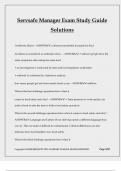Exam (elaborations)
Servsafe Manager Exam Study Guide Solutions
Institution
ServSafe Manager
Servsafe Manager Exam Study Guide
Solutions
foodborne illness - ANSWER-a disease transmitted to people by food
An illness is considered an outbreak when... - ANSWER-• atleast 2 people have the
same symptoms after eating the same food
• an investigation is conducted by state and local regul...
[Show more]
Preview 4 out of 92 pages
Uploaded on
November 19, 2024
Number of pages
92
Written in
2024/2025
Type
Exam (elaborations)
Contains
Questions & answers
Institution
ServSafe Manager
Course
ServSafe Manager
$12.49
Also available in package deal from $41.95
100% satisfaction guarantee
Immediately available after payment
Both online and in PDF
No strings attached
Also available in package deal (1)
1. Exam (elaborations) - Servsafe exam review questions and answers 100% pass
2. Exam (elaborations) - Servsafe food handler practice test questions and answers 100% pass
3. Exam (elaborations) - Servsafe food safety manager exam: 7th edition study guide solutions updated
4. Exam (elaborations) - Servsafe manager 2024 practice exam questions and answers 100% pass
5. Exam (elaborations) - Servsafe manager certification exam practice questions and answers 100% pass
6. Exam (elaborations) - Servsafe manager chapter 1 practice questions and answers 100% pass
7. Exam (elaborations) - Servsafe manager exam practice questions and answers 100% pass
8. Exam (elaborations) - Servsafe manager exam study guide solutions
Show more
Servsafe Manager Exam Study Guide




